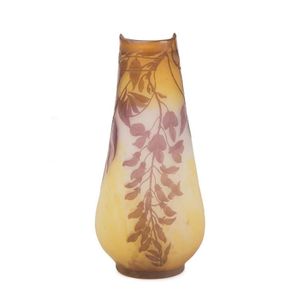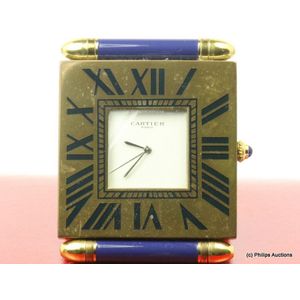Rococo Tortoiseshell & Ormolu Mantle Clock, Paris, 1900
You must be a subscriber, and be logged in to view price and dealer details.
Subscribe Now to view actual auction price for this item
When you subscribe, you have the option of setting the currency in which to display prices to $Au, $US, $NZ or Stg.
- Tortoiseshell - Tortoiseshell is a translucent material that comes from the horny carapace of a certain types of turtles, including the hawksbill turtle. It is often therefore mounted on a colour underground - often red - or inlaid with gold or silver thread, as seen in Boulle furniture.
The texture and colour nuances of the material are extremely important. Heated tortoiseshell can easily be formed into various shapes. Like other natural materials, tortoiseshell becomes more beautiful with use. In a time before plastic, tortoiseshell was widely used for small objects such as combs and powder compacts.
In 1973, the trade of tortoiseshell worldwide was banned under CITES (The Convention on International Trade in Endangered Species). Prior to importing or exporting items containing tortoiseshell a CITES permit must be obtained. Tortoiseshell items cannot be traded on Ebay.
"Faux tortoiseshell", another case of man initiating nature, is made from old-style plastics such as celluloid and cellulos and is coloured with red, yellow and brown spots to imitate the genuine article. It is commonly used in glasses frames, musical instruments and costume jewellery. - Ormolu - Ormolu was popular with French craftsmen in the 18th and 19th century for ornamental fittings for furniture, clocks and other decorative items. True ormolu is gilt bronze, that is bronze that has been coated with gold using a mercury amalgam. Due to the health risks associated with using mercury, this method of creating ormolu was discontinued in France in the 1830s. A substitute was developed consisting of about 75% copper and 25% zinc, however it was inferior to the bronze version. It was often lacquered to prevent it tarnishing.
- Pagoda Top - A shape based loosely on that of a Chinese pagoda, that is, pyramidal with sloped sides and a top cap. However there are many variations on the basic shape from a relatively flat pagoda to a tall pagoda with almost parallel concave sides to a true pagoda shape. As found on a pagoda, the pagoda top is often surmounted by a fancy finial. The pagoda top is most frequently found on the hoods of 18th century long case clocks, and on bracket clocks, and sometimes on Chinese Chippendale style furniture.
- Pendulum - The pendulum was discovered around 1602 by Galileo Galilei, and was adopted for time keeping by the Dutch mathematician and natural philosopher, Christiaan Huygens, who excelled in astronomy, physics, and horology.
The pendulum comprises a metal rod usually of brass or steel with a metal disk, known as a bob, at the end. The movement of the pendulum is driven by weights or a spring, and as a pendulum swings in a regular arc, it was found accuracy could be controlled to within a few seconds a week.
Timekeeping can be adjusted by changing the height of the bob on the rod, making the pendulum either swing slower or faster.
The disadvantage of the pendulum was that changes in temperature also changed the length of the pendulum, interfering with the accuracy of the clock, and so in the 18th century two types of mercurial pendulums were invented which countered the movement in the steel rod.
The pendulum was the world's most accurate timekeeping technology until the invention of the quartz clock, regulated by a quartz crystal, in 1927. - Mahogany - Mahogany is a dense, close grained red-coloured timber from the West Indies and Central America. It was first imported into Europe in the the early 18th century and its use continued through the 19th century. It was popular for furniture making because of its strength, the wide boards available, the distinctive grain on some boards, termed flame mahogany and the rich warm colour of the timber when it was polished.. The "flame" was produced where a limb grew out from the trunk of the tree, and this timber was usually sliced into veneers for feature panels on doors, backs and cornices.
Some terms used to describe mahogany relate to the country from which it originally came, such as "Cuban" mahogany, "Honduras" mahogany etc. However unless the wood has been tested the names assigned are more a selling feature, rather than a true indication of the timber's origin.
This item has been included into following indexes:
-
clocks, mantle & shelf, material or style
- gilt metal / ormolu 536
- mahogany 70
- clocks, mantle & shelf, period or origin - French 737
- clocks, material or decoration - tortoiseshell cased 99
Visually similar items

A Len Castle stoneware bowl, circular, raised on a small tapering foot ring, green talc glaze to the interior and darker mottled green glaze to the exterior, impressed artist's cypher under the base. Diameter 38.5 cm

An emerald and diamond bracelet, the nine articulated panels set with emerald cut emeralds totalling 12.96cts, surrounded by diamonds totalling 6.70cts, mounted in 18ct white gold, total length 180 mm.

A Galle cameo glass vase, French, circa 1900, signed Gall e, 34.5 cm high

A Cartier Quadrant travel clock, quartz, the attractive white square dial with Roman Numerals in lapis blue enamel on the outer bezel. Displays beautifully on its flip-over hinged base stand. Classic Cartier blue cabochon for adjusting the time. Marks at b
